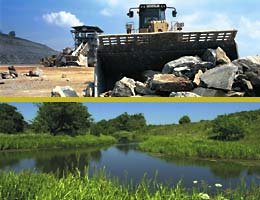
| VIRTUAL QUARRY | ROCK SPOT | TEACHER'S DESK | HOMEABOUT US CONTACTSITE MAP |
| Briefings UNITS Quarry Visits Media Library Teenage Safety | |||
| QUARRY VISITS | LOCATE YOUR NEAREST SITE FOR A SCHOOL VISIT | |||
| The Virtual Quarry is a great resource for learning and understanding why we need quarrying and how the industry works. However, nothing can beat the real thing, and we encourage organised school visits to operational or restored quarry sites whenever possible. Find out more details about some of those that welcome visits by clicking on your region in the map on the right. There are two main types of active land quarries shown: those that produce crushed rock and those that produce sand and gravel, plus a small number of clay quarries. You can also visit sites which have been restored – you would never know they were once quarries. Many are now nature reserves in the ownership of English Nature or the RSPB and have a warden and a visitor centre. You will notice some major differences between rock and sand and gravel quarries. The former tend to be longer-term, deeper and dug on several different levels or “benches”. Rock is blasted from the ground using carefully controlled explosions, and is then taken to a crusher, where it is broken down into smaller pieces, and separated into different sizes. |
|
|||
Sand and gravel quarries are usually much shorter-term, shallower and worked and restored in progressive phases. Once the topsoil has been removed, the aggregate is dug from the ground and taken to a processing plant where the clay and silt is removed and the sand and gravel is separated into different grades. Crushed rock or sand and gravel are mixed with cement to make ready-mixed concrete, and with bitumen to make asphalt for the surfaces of our roads. Some of the quarries listed here have concrete or asphalt plants on-site. On a typical visit to a working quarry, children will be given safety gear and taken on a tour by the quarry manager, who explains how the quarrying process works. Occasionally, rock quarries may be able to arrange for a blast to take place, which is sure to live in the memory of visiting children! Restored quarries often afford opportunities to look into ecosystems and biodiversity in detail. A trip to a restored quarry can particularly bring to life the teaching units held on this website.
Contact details for each site are listed, and the MPA can
support you on your trip if needed. |
||||
| |
||||
